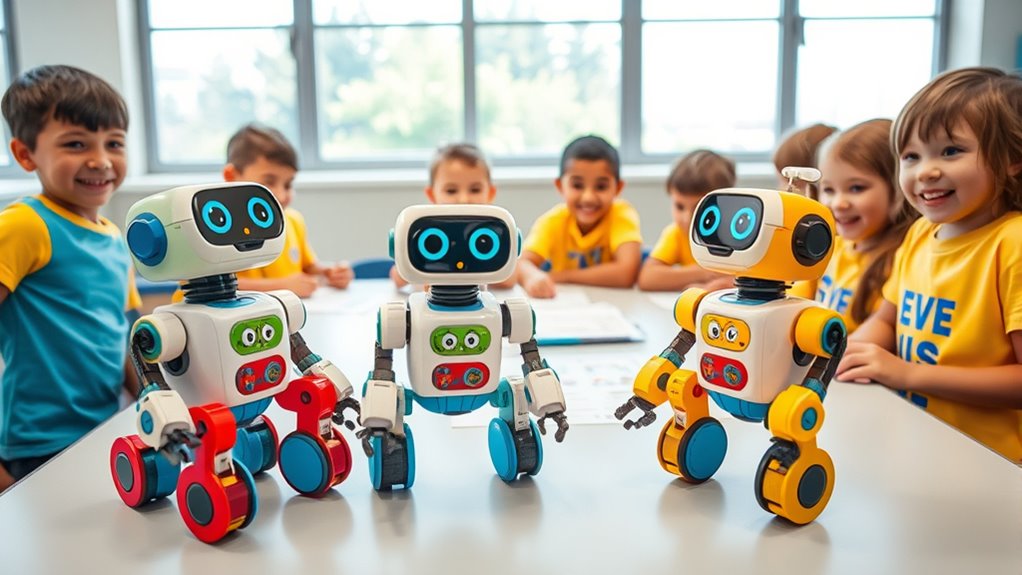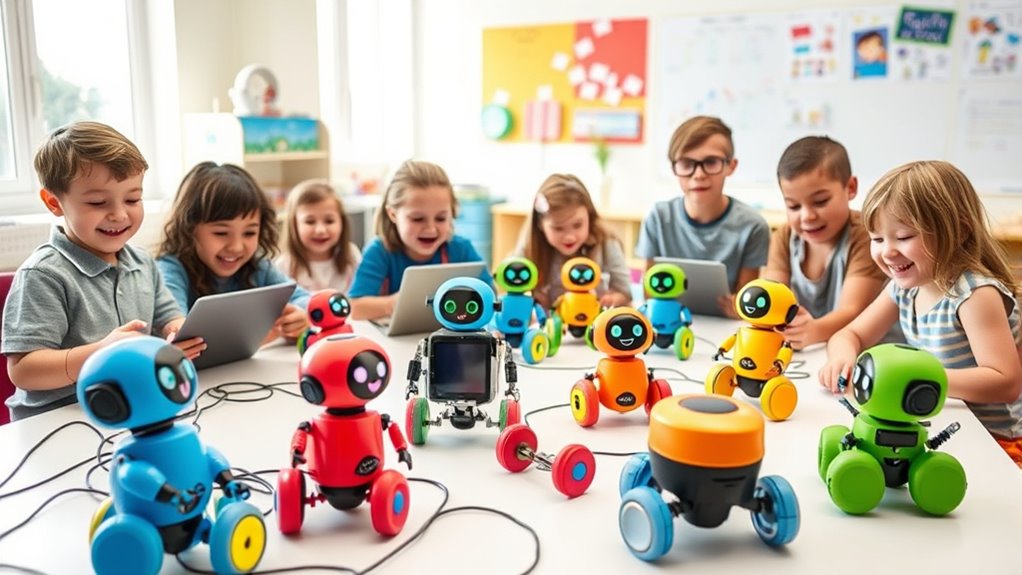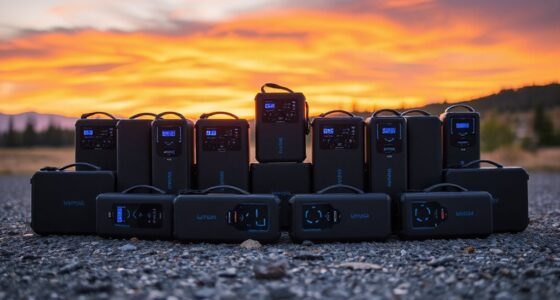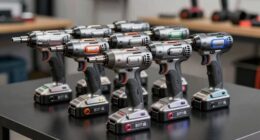If you’re looking for fun and easy coding robots for kids, I’ve found 15 top options that combine engaging features with educational value. From beginner-friendly kits like Botley and Dash to more advanced ones like mBot and Sphero Mini, there’s something for every age and skill level. These robots promote critical thinking, problem-solving, and creativity while making learning to program enjoyable. Keep exploring to discover how each robot can boost your child’s STEM skills and spark their curiosity.
Key Takeaways
- The list includes beginner-friendly robots like Botley, Dash, and Sphero Mini that simplify coding for kids aged 4-12.
- Many robots support visual programming with drag-and-drop interfaces like Scratch, Blockly, or app-based coding.
- These robots offer interactive features such as lights, sounds, obstacle avoidance, and movement to make learning engaging.
- They promote STEM skills, problem-solving, and creativity through hands-on activities and open-ended challenges.
- The selection covers various age ranges and skill levels, ensuring fun and easy programming experiences for all children.
Learning Resources Botley Coding Robot STEM Toy
If you’re looking for a coding robot that introduces young children to STEM concepts in a fun and engaging way, the Learning Resources Botley Coding Robot STEM Toy is an excellent choice. Designed for kids as young as five, it offers advanced features like obstacle avoidance, object detection, looping commands, and black-line following. Ready to use right out of the box with batteries (not included), it comes with a 45-piece activity set, coding cards, and accessories. Botley responds with sounds and lights, making learning interactive. Its compact size and hidden features keep kids excited to explore coding while developing critical thinking and problem-solving skills.
Best For: young children aged 5 and up who are beginning to explore coding and STEM concepts in a fun, interactive, and screen-free environment.
Pros:
- Introduces early STEM skills with engaging, hands-on activities and interactive features like sounds and lights.
- Includes a comprehensive 45-piece activity set with coding cards, obstacles, and accessories for creative play.
- Supports logical thinking and problem-solving with features like obstacle avoidance, black-line following, and looping commands.
Cons:
- Some features such as obstacle detection and black-line following can be finicky, especially on carpets or with precise alignment.
- Limited number and small size of black-line cards may restrict extended gameplay.
- High battery consumption requires frequent replacements, which can be inconvenient.
Mech 5, Mechanical Coding Robot
The Mech 5 Mechanical Coding Robot stands out as an ideal entry-level STEM toy for kids aged 10 and up who are enthusiastic to explore mechanical engineering and coding through hands-on play. This robot offers a fun, mission-based experience that teaches core engineering principles and coding skills. Kids can make it throw, lift, kick, and draw by snapping coding buttons onto its wheel, allowing versatile movements. It encourages building and programming with the simple motto: “Build it. Code it. Watch it move!” Perfect for young aspiring engineers, the Mech 5 sparks creativity, problem-solving, and foundational STEM knowledge through engaging, interactive fun.
Best For: young aspiring engineers aged 10 and up who want to explore mechanical engineering and coding through hands-on, interactive play.
Pros:
- Engages children with mission-based activities that promote experiential learning.
- Versatile functions allowing the robot to throw, lift, kick, and draw by snapping coding buttons onto its wheel.
- Fosters creativity, problem-solving, and foundational STEM skills in an enjoyable way.
Cons:
- May require adult supervision or guidance for younger users to maximize learning.
- Limited advanced programming features suitable for more experienced coders.
- Assembly and understanding of mechanical and coding concepts might be challenging for some beginners.
Dash Robot – Voice-Activated Coding Robot for Kids 6
Designed for children aged 6 and up, Dash Robot stands out as an excellent choice for young learners just beginning their coding journey. This voice-activated, interactive STEM toy arrives ready to use, with no assembly needed. It can sing, dance, navigate obstacles, and respond to voice commands, all while changing colors and providing endless fun. Its durable design, smooth motors, and up to 5 hours of playtime make it perfect for kids and classrooms alike. Through simple apps, Dash introduces core coding concepts like sequencing, loops, and variables. It’s intuitive, engaging, and adaptable, making learning to program both fun and accessible for young beginners.
Best For: young children aged 6 and up, beginners in coding, and educators seeking an engaging STEM tool for classroom or home use.
Pros:
- User-friendly, voice-activated interface that encourages early coding skills
- Durable, sleek design with smooth motors capable of navigating various terrains
- Offers a variety of apps suitable for different age levels, promoting growth in programming understanding
Cons:
- Lack of a built-in camera limits some advanced interaction features
- No physical user manual included, requiring reliance on online tutorials for setup and troubleshooting
- Limited code export/view options for in-depth understanding and troubleshooting of programming code
Makeblock mBot Robot Kit for Kids Aged 8-12 STEM Learning and Coding
Looking for a beginner-friendly robotics kit that makes learning to code fun and accessible? The Makeblock mBot Robot Kit is perfect for kids aged 8-12 who want hands-on STEM learning. It’s easy to assemble in about 15 minutes with clear instructions, and it supports Scratch and Arduino programming environments. Kids can explore electronics, robotics, and coding through engaging tutorials, coding cards, and software like mBlock. The robot can follow lines, avoid obstacles, and be customized with over 100 modules and LEGO parts. Its durability and versatility make it a fantastic tool to foster creativity, problem-solving, and technological skills.
Best For: young children aged 8-12 who are interested in beginner-friendly STEM learning, robotics, and coding projects.
Pros:
- Easy to assemble within 15 minutes with clear instructions, making it accessible for beginners.
- Supports both Scratch and Arduino programming environments, allowing for progressive learning.
- Highly customizable with over 100 electronic modules and compatibility with LEGO parts for creative projects.
Cons:
- Some users experience initial setup challenges with software or firmware updates.
- Limited advanced programming features may require additional resources for older or more experienced learners.
- Small parts or missing components can occasionally occur, requiring customer support assistance.
Sphero Mini (Blue) Coding Robot Ball for Kids and Teens
If you’re introducing kids or teens to coding and robotics, the Sphero Mini (Blue) stands out as an engaging and accessible option. Its compact, ping-pong ball size makes it portable and perfect for small spaces. Using the free Sphero Edu app, kids can learn to code by drawing, dragging blocks, or writing JavaScript, making it ideal for beginners aged 8 and up. With multiple driving modes and obstacle course accessories, it offers interactive play and hands-on learning. Plus, it doubles as a game controller for fun arcade-style games. The Sphero Mini inspires creativity while teaching essential STEAM skills in a fun, easy-to-use package.
Best For: beginners, kids aged 8 and above, and educators seeking an engaging introduction to coding and robotics in small spaces.
Pros:
- Compact size makes it portable and easy to use in limited areas
- Multiple coding options including drawing, block-based, and JavaScript for versatile learning
- Includes accessories and game modes to promote interactive, hands-on fun and creativity
Cons:
- Approximately 1 hour of playtime per charge may require frequent recharging during extended use
- Limited advanced features may not satisfy more experienced robotics enthusiasts
- Some users might find the setup or app interface slightly challenging initially
Learning Resources Code & Go Robot Mouse Activity Set
The Learning Resources Code & Go Robot Mouse Activity Set is an excellent choice for young children ages 4 and up who are just starting to explore coding and STEM concepts. This hands-on set includes a programmable robot mouse, maze pieces, walls, tunnels, and coding cards, allowing kids to build mazes and plan routes. They program the mouse using color-coded buttons, promoting critical thinking, sequencing, and problem-solving. With lights, sounds, and adjustable speeds, the mouse makes learning engaging and intuitive. Its durable design and variety of challenges make it perfect for both home and classroom use, fostering early coding skills and creativity in a fun, screen-free way.
Best For: young children aged 4 and up who are beginning to explore coding, STEM concepts, and problem-solving through hands-on play.
Pros:
- Encourages critical thinking, sequencing, and problem-solving skills in a fun, engaging way
- Promotes creativity through customizable maze configurations and open-ended challenges
- Durable design suitable for both home and classroom environments, fostering early STEM learning
Cons:
- Assembly of maze pieces may require adult assistance for younger children
- Requires 3 AAA batteries (not included), which could be an inconvenience for some users
- Some users suggest clearer packaging information on batteries and setup instructions for gift-givers
Educational Insights Artie 3000 Coding Robot Drawing STEM Toy
Educational Insights Artie 3000 is an ideal coding robot for kids aged 7 and up who want to combine creativity with STEM learning. I love how it lets children code patterns, shapes, and custom artwork that Artie then draws in full color on paper. Supporting four programming languages—Blockly, Snap!, JavaScript, and Python—it caters to beginners and advanced coders alike. Setup is simple—just insert four AA batteries and connect via Wi-Fi. Kids can experiment with coding line-by-line, create designs, and explore problem-solving, all while blending art and technology. Despite some connectivity quirks, it’s a fun, engaging way for children to learn programming hands-on.
Best For: children aged 7 and above who want to learn coding through hands-on art creation and STEM activities.
Pros:
- Supports multiple programming languages (Blockly, Snap!, JavaScript, Python) suitable for all skill levels
- Encourages creativity and problem-solving by allowing kids to design and draw custom artwork
- Easy setup with simple Wi-Fi connection and included activity resources
Cons:
- May experience connectivity issues or firmware malfunctions requiring troubleshooting
- Some units can have hardware defects, affecting movement or drawing capabilities
- The web-based coding interface can be less user-friendly on smartphones compared to larger screens
ELEGOO UNO R3 Robot Car Kit V4 for Arduino STEM Science Kits for Kids and Teens
Designed for beginners, the ELEGOO UNO R3 Robot Car Kit V4 is perfect for kids aged 8-16 who want to immerse themselves in programming and robotics. This STEM kit offers hands-on experience with assembly, electronics, and coding via Arduino IDE, supporting complex projects like obstacle avoidance, line following, and remote control. Its sturdy parts and clear labels make building straightforward, though small components can be tricky for newcomers. The kit’s versatility includes WiFi control, a camera, and customizable features, encouraging creativity. While some programming challenges exist, especially for beginners, the kit provides a solid foundation for developing engineering skills and exploring advanced modifications.
Best For: beginners and kids aged 8-16 interested in hands-on robotics, programming, and electronics projects using Arduino.
Pros:
- Easy assembly with labeled parts and sturdy components suitable for beginners.
- Supports multiple control modes including remote, WiFi, and manual operation, enhancing versatility.
- Encourages creativity and engineering skills through customizable hardware and complex programming options.
Cons:
- Small parts can be challenging for newcomers to handle and assemble correctly.
- Complex coding and software setup may be difficult for absolute beginners, requiring troubleshooting and library adjustments.
- WiFi connectivity and control range can be inconsistent, especially at longer distances or in weak signal environments.
Thames & Kosmos Robotics Smart Machines Junior STEM Kit
If you’re looking for a beginner-friendly robotics kit for kids aged 8 and up, Thames & Kosmos Robotics Smart Machines Junior STEM Kit is an excellent choice. It lets children build and code a 9-inch robot with over 200 customizable actions, all through a simple block-based app. The robot can be controlled via buttons or programmed with an easy-to-use app compatible with Android and iOS devices. This kit promotes problem-solving, critical thinking, and creativity while providing hands-on STEM learning. As part of the award-winning Robotics: Smart Machines series, it’s a trusted, engaging way to introduce kids to robotics and programming in a fun, accessible way.
Best For: beginners and children aged 8+ interested in exploring robotics and programming in an engaging, accessible way.
Pros:
- Easy-to-use block-based coding app suitable for beginners
- Offers customizable actions with over 200 options for creative expression
- Includes multiple control options: screen-free buttons and app programming
Cons:
- Limited to a 9-inch robot, which may be less suitable for more advanced projects
- Requires compatible Android or iOS devices for programming features
- May have a learning curve for children new to robotics and coding concepts
Learning Resources Cooper The STEM Robot for Kids
Looking for a hands-on way to introduce young children to coding? Learning Resources Cooper The STEM Robot is perfect for kids aged 5 and up. It offers engaging, screen-free activities using simple command buttons and 40 coding cards, making programming easy and tactile. With four interactive modes—line tracking, optical sensing, obstacle avoidance, and robot communication—it encourages exploration, critical thinking, and creativity. The kit includes a rechargeable robot, an activity guide with STEM challenges, and accessories, providing a complete learning experience. It’s ideal for home, school, or homeschool settings, supporting early coding skills with minimal setup and adult guidance.
Best For: young children aged 5 and up, parents, teachers, and homeschoolers seeking a hands-on, screen-free introduction to coding and STEM concepts.
Pros:
- Engages children with interactive, multi-mode activities that promote critical thinking and creativity.
- Offers a complete STEM learning kit with rechargeable robot, coding cards, and activity challenges.
- Screen-free design with simple command buttons makes programming accessible and tactile for young learners.
Cons:
- May require adult guidance initially to maximize learning and engagement.
- Limited to the four interactive modes; advanced coding features are not included.
- The robot’s functionality is primarily designed for introductory use, possibly needing upgrades for more complex projects.
Learning Resources Botley The Coding Robot 2.0 Activity Set
The Learning Resources Botley The Coding Robot 2.0 Activity Set stands out as an excellent choice for young children aged 5 and up who are just beginning to explore coding concepts. This 78-piece set includes Botley 2.0, a remote programmer, coding cards, obstacle pieces, and accessories that promote hands-on learning. Botley 2.0 introduces kids to sequences, loops, and logical thinking through fun activities like line following, obstacle navigation, and light shows. Its screen-free design makes coding accessible and engaging for early learners. Durable and easy to operate, it encourages creativity, problem-solving, and critical thinking while providing hours of educational entertainment.
Best For: young children aged 5 and up who are beginning to learn coding concepts through hands-on, screen-free play.
Pros:
- Promotes STEM skills such as critical thinking, spatial reasoning, and problem-solving
- Durable, colorful components designed for active play and easy construction
- Offers multiple coding methods and interactive activities to keep children engaged
Cons:
- Fixed turn angles (90° or 45°) may lead to minor programming inaccuracies
- Some users experience initial difficulty with programming understanding or connectivity issues
- Battery life and replacement can be inconvenient, especially without rechargeable options
Makeblock mBot2 Coding Robot for Kids
The Makeblock mBot2 Coding Robot is an excellent choice for children aged 8-12 who want to explore robotics and coding hands-on. It offers engaging projects and courses that teach AI, programming, game development, and data science, supporting lifelong learning with evolving curricula. Easy to assemble in about 30 minutes, it features advanced sensors for obstacle avoidance, line-following, and color detection. Kids can control mBot2 via app using block-based coding with Bluetooth, USB, or Wi-Fi. Its playful AI interactions, like changing lights or making sounds, make learning fun, fostering creativity and problem-solving skills in a portable, user-friendly design.
Best For: children aged 8-12 interested in learning robotics, coding, and AI through hands-on projects and interactive play.
Pros:
- User-friendly assembly suitable for beginners with step-by-step instructions.
- Supports multiple programming languages including Scratch and Python, fostering diverse learning.
- Equipped with advanced sensors for obstacle avoidance, line-following, and color detection, enhancing practical skills.
Cons:
- Requires a compatible device (smartphone or tablet) for app control, which may be an additional cost.
- Limited battery life of around 5 hours may require frequent recharging during extended play or learning sessions.
- Advanced features and expansion modules might be complex for complete beginners to fully utilize without additional guidance.
Learning Resources Code & Go Robot Mouse – 31 Pieces, Ages 4
For parents and educators seeking an engaging way to introduce young children to coding, the Learning Resources Code & Go Robot Mouse is an excellent choice. This set includes 31 pieces designed for kids aged 4 and up, offering a screen-free coding experience. Kids can program the mouse using pictorial direction cards and push buttons, making it simple to learn sequencing and problem-solving. The mouse lights up and sounds, with adjustable speeds for different play environments. It’s a fantastic STEM tool that promotes critical thinking, spatial understanding, and logical skills in a fun, interactive way, perfect for early learners and gift-giving occasions.
Best For: parents, educators, and caregivers looking to introduce young children aged 4+ to coding and STEM concepts through an interactive, screen-free activity.
Pros:
- Encourages problem-solving, critical thinking, and spatial skills in early learners
- Simple to program using pictorial cards and push buttons, ideal for young children
- Promotes hands-on learning with a fun, engaging robot mouse that lights up and sounds
Cons:
- Requires 3 AAA batteries, which are not included
- Limited to basic coding concepts suitable for beginners, may need additional resources for advanced learners
- The set’s small size might be less engaging for multiple children to play simultaneously
STEM Robotics Science Kits for Kids 6-12
If you’re looking for a hands-on way to introduce kids aged 6-12 to STEM concepts, these robotics kits are an excellent choice. They feature 6-in-1 sets with a reptile robot, balance car, bubble machine, fiber lamp, and buzzer wire game, all with safe, odorless parts and easy-to-follow instructions. Kids can build, customize, and explore electronics, physics, and engineering while developing problem-solving skills and fine motor coordination. These kits promote learning through play, making science engaging and accessible. Plus, they’re perfect for family bonding or gifts, inspiring creativity and curiosity in young STEM enthusiasts.
Best For: children aged 6-14 who are interested in hands-on STEM learning, robotics, and science exploration.
Pros:
- Promotes engaging learning through building and customizing electronic gadgets.
- Includes detailed instructions and safe, odorless parts suitable for young learners.
- Encourages family bonding and makes for thoughtful, educational gifts.
Cons:
- Small, delicate parts may require precision tools and careful handling.
- Some instructions may be low in resolution, leading to potential assembly challenges.
- Occasional design flaws like weak motors or fragile attachments can affect project durability.
Learning Resources Switcheroo Coding Crew – STEM Robotics & Programming Toy
Are you looking for an engaging way to introduce young children to coding and robotics? The Learning Resources Switcheroo Coding Crew is perfect for kids aged 4-6. It features a transformable rescue robot, a 46-piece town set, and interchangeable vehicle shells like police cars and fire trucks. Kids can program the robot using simple buttons in Code Mode or complete rescue missions across a puzzle town. The set promotes problem-solving, logical thinking, and spatial skills without screens. Durable and easy to customize, it encourages creativity and teamwork. While assembly can be tricky, many parents praise its educational value and fun gameplay, making it a great gift for young aspiring coders.
Best For: young children aged 4-6 who are interested in exploring coding, robotics, and problem-solving through hands-on, screen-free play.
Pros:
- Promotes early coding, logical reasoning, and spatial skills in a fun, interactive way
- Durable construction with easy-to-change vehicle shells and engaging lights and sounds
- Encourages creativity, storytelling, teamwork, and independent learning
Cons:
- Assembly of vehicle shells and puzzle components can be challenging for some children or parents
- Some materials, such as cardboard pieces, may be less durable over time
- Instructions may require adult assistance for younger children to set up and understand effectively
Factors to Consider When Choosing Coding Robots for Kids

When choosing coding robots for kids, I think about several key factors to ensure a good fit. It’s important to consider age appropriateness, skill level, and how easy the programming interface is to use. Additionally, durability and the educational value of the robot play crucial roles in making the right choice.
Age Appropriateness
Choosing the right coding robot for a child starts with considering their developmental level to guarantee the device is both engaging and educational. It’s important to pick a robot whose recommended age range matches the child’s abilities, ensuring they can understand and interact with it effectively. For younger kids (ages 4-6), simple, screen-free robots that emphasize tactile play and basic coding concepts work best. Older children (ages 8-12) can handle more complex robots with advanced programming features and customization options. Also, consider whether the robot’s design and complexity align with the child’s motor skills and cognitive development. Selecting age-appropriate robots helps prevent frustration and ensures the learning experience is both fun and meaningful, fostering a positive attitude toward STEM.
Skill Level Match
Matching a coding robot’s complexity to a child’s skill level is essential for an engaging and effective learning experience. If the robot is too simple, kids may quickly lose interest; too complex, and they’ll feel frustrated. For beginners aged 4-8, look for robots that use visual block-based coding, which makes learning intuitive. As kids grow, they can progress to text-based languages like Python or JavaScript. Choose robots with adjustable difficulty settings or expandable features so they can grow with your child’s skills. Guided tutorials and challenges tailored to different levels also help maintain motivation and ensure steady progress. Ultimately, matching the robot’s capabilities with your child’s current understanding of concepts like sequencing and loops fosters confidence and keeps learning fun.
Programming Interface
A user-friendly programming interface is essential for making coding accessible and enjoyable for kids. Visual block-based systems or drag-and-drop features simplify coding, especially for younger children just starting out. For older kids, text-based options like Python or JavaScript can offer more depth as their skills grow. Compatibility with tablets, smartphones, or computers ensures flexible access, so learning can happen anytime, anywhere. Clear menus and prompts help kids navigate without frustration, making the experience seamless. Additionally, tutorials, guided lessons, and in-app help can boost confidence and shorten the learning curve, encouraging continued exploration. A well-designed interface can turn coding from a formidable task into an engaging, fun journey, fostering confidence and curiosity in young learners.
Durability & Build
Since kids can be quite energetic and sometimes rough with their toys, durability is a crucial factor when selecting coding robots. Look for robots made from high-quality, impact-resistant plastics or metals that can handle drops and bumps without damage. Reinforced joints and sturdy wheels are essential for enduring frequent movement and active play. Water-resistant or sealed components help protect internal electronics from spills and dust, extending the robot’s lifespan. A well-designed chassis with reinforced corners reduces the risk of cracks or deformation over time. Additionally, reliable batteries or rechargeable power sources ensure consistent performance and minimize the need for replacements. Choosing a durable robot means it will withstand the rigors of active learning, making it a worthwhile investment that keeps kids engaged longer.
Educational Value
Choosing a coding robot that offers meaningful educational value means looking beyond durability and considering how well it teaches core programming skills. A great robot introduces concepts like sequencing, loops, and conditionals through engaging activities, making abstract ideas tangible. It should support multiple learning modes—visual programming, command-based coding, and hands-on building—to suit different learning styles and developmental stages. Incorporating STEM principles such as electronics, mechanics, and problem-solving not only deepens understanding but also boosts critical thinking. An effective educational robot offers progressive learning opportunities, allowing kids to advance from simple to complex tasks as they grow. Additionally, thorough guides, challenges, and curriculum-aligned lessons maximize engagement and ensure the robot’s educational impact is meaningful and lasting.
Expandability Options
When evaluating coding robots for kids, it’s essential to take into account their expandability options, as these features can considerably extend the robot’s learning potential. Many robots support additional modules, sensors, or attachments that boost functionality and keep learning engaging. Software updates or new programming features also allow kids to develop skills without needing new hardware. Compatibility with third-party accessories or kits can further customize the robot, catering to different interests or skill levels. Modular designs enable easy swapping or upgrading of parts, making future modifications simple and affordable. Additionally, the ability to connect to external devices or integrate with other systems opens up expanded coding environments and collaborative learning opportunities, ensuring the robot grows alongside the child’s abilities.
Control Methods
Selecting the right control method is essential because it directly impacts how kids interact with and learn from their coding robots. Different control options, like remote control, app-based programming, voice activation, and programmable buttons, offer various ways to engage. Wireless controls such as Bluetooth, Wi-Fi, or infrared connect robots to smartphones, tablets, or remote controls, providing flexibility and ease of use. App-controlled robots often support drag-and-drop or block-based coding, making learning scalable as kids progress. Voice-activated robots respond to spoken commands, making control more intuitive, especially for younger children. Programmable buttons on the robot itself give a tactile, screen-free experience. Choosing a control method aligned with a child’s age, interests, and learning style enhances their engagement and understanding of programming concepts.
Price & Budget
Considering the variety of control options available, it’s important to think about your budget before making a purchase. Coding robots for kids range from around $30 for basic models to over $200 for more advanced sets. When choosing, consider the long-term value and educational features that fit your child’s learning needs. Higher-priced robots often offer more programming options, accessories, and durability, which can justify the cost. However, there are affordable options that cover essential coding skills and can expand over time. Be sure to look for deals like discounts, bundles, or educational kits, which can provide better value and enhance the learning experience. Balancing cost with functionality helps ensure you select a robot that’s both educational and within your budget.
Frequently Asked Questions
Which Coding Robot Is Best Suited for Absolute Beginners?
When choosing a coding robot for absolute beginners, I look for something simple, intuitive, and engaging. I recommend starting with a robot like the Botley, because it doesn’t require screens or prior coding knowledge. It’s perfect for learning foundational concepts through hands-on activities. Plus, its user-friendly design keeps kids motivated and makes learning to program a fun, approachable experience.
How Safe Are Coding Robots for Young Children?
Imagine a gentle guardian guiding a child through a bustling fair—coding robots are much like that. They’re designed with safety as a top priority, featuring sturdy builds, rounded edges, and secure connections. I’ve found that reputable brands rigorously test their robots, ensuring they’re safe for young hands. Of course, adult supervision remains key, making sure little explorers navigate their robotic adventures safely and happily.
Can These Robots Be Used for Classroom Teaching?
Absolutely, these robots are great for classroom teaching! I’ve seen how they engage students and make learning coding interactive and fun. Teachers can integrate them into lessons easily, encouraging teamwork and problem-solving skills. Plus, many robots come with user-friendly platforms, so even beginners can set up and start teaching without hassle. I believe they’re a fantastic tool to enhance STEM education and inspire young learners.
Do Coding Robots Support Multiple Programming Languages?
Imagine a chef with a versatile toolkit—that’s how I see coding robots supporting multiple languages. Many of these robots, like LEGO Mindstorms or Botley, can handle block-based coding and even languages like Python or JavaScript. This flexibility is like having a Swiss Army knife for coding, allowing kids to explore different programming styles. It makes learning more adaptable and prepares them for diverse tech challenges ahead.
What Are the Maintenance and Charging Requirements?
When it comes to maintenance and charging, I find that most coding robots are pretty straightforward. They usually require regular charging, often via USB or a dedicated charging dock, which takes a couple of hours. Maintenance mostly involves keeping sensors and wheels clean and updating firmware when needed. I recommend checking the user manual for specific details, but overall, they’re designed to be low-maintenance so kids can focus on programming fun!
Conclusion
Choosing the right coding robot can transform learning into an exciting adventure. Imagine your child’s eyes lighting up as they discover new skills, steering through challenges like a true coder. With so many options, each promising to spark curiosity and creativity, the perfect robot is just a decision away. Are you ready to help your kid step into the future of tech? The possibilities are endless—and the journey begins now.


























